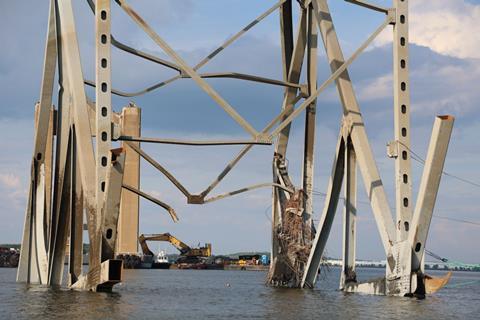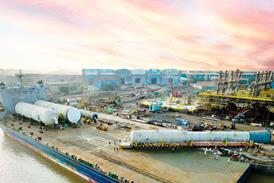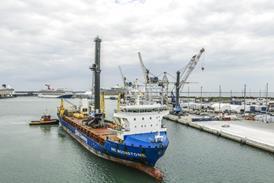The collapse of the Francis Scott Key Bridge is not expected to have any long-term supply chain impact but is likely to result in the largest marine insurance claim in history, writes Gregory DL Morris.

The sudden closure of the port of Baltimore because of the collapse of the Francis Scott Key Bridge on March 26 may have a negative impact on the regional economy in the near term, but should not affect global supply chains, according to US financial ratings agency Morningstar DBRS. The bridge collapsed, killing six workers, after the containership Dali lost power and hit a bridge support.
“The port’s credit profile should be largely insulated from volume decline, as the majority of revenues are derived from terminal leases,” Morningstar wrote in its analysis of the incident. “Terminal operators may feel the effect of volume loss, with magnitude dependent on the length of the closure and the geographic diversification of the operator.
“Automotive ro-ro volume may be heavily affected and need to be redirected to other nearby ports, but OEMs should be able to manage the disruption.”
Largest marine claim
However, the bridge collapse and port blockage are “likely to be the largest marine insurance claim in history, surpassing the USD1.5 billion loss on the Costa Concordia sinking in 2012,” according to an analysis by Brian C Schneider, senior director of Fitch Ratings. “While losses could range from USD2-4 billion, the ultimate insured loss will depend on the length of the blockage and the nature of business interruption coverage”, of the numerous parties affected.
Whatever the full loss, most of it is expected to be borne by the International Group of Protection & Indemnity (P&I) Clubs’ reinsurance pool, Schneider suggested. “A USD2-4 billion industry loss, which is anticipated to be spread widely across carriers, would not have a rating impact on large reinsurers,” Schneider suggested, “including AXA XL, the lead underwriter on the reinsurance policy, Munich Re, Swiss Re, SCOR, Hanover, and Lloyd’s of London.”
Marine cargo insurance growth
Meanwhile, the global marine cargo insurance market is anticipated to grow from USD20.8 billion in 2023 to USD34 billion by 2032, a compound annual growth rate of 5.86 percent, according to a report by Astute Analytica India.
Marine cargo loss, theft and global trade dynamics continue to pose significant challenges in 2024, the report said. “Notably, global cargo theft incidents have surged by 10 percent from 2022 to 2024, with the average loss value per incident reaching USD300,000 in 2023.
Food and beverages remain the most targeted commodities, and in the first quarter of 2024 alone, 180 cargo theft events were recorded in the USA and Canada. Despite efforts to combat theft, less than 25 percent of stolen cargo is ever recovered, according to recent FBI data. All these factors add fuel to the growth of the global marine cargo insurance market.”
The perception of cargo theft as a low-risk, high-reward crime persists, with many incidents going unpunished, the report noted. “International crime syndicates are often behind large-scale theft operations, driven by the global economic situation and increased demand for black-market goods.”
Macroeconomic trends
While project cargo and delay-in-startup insurance are separate lines from general cargo, the same macroeconomic trends affect the entire marine segment.
Open marine insurance policies are becoming increasingly popular among cargo companies in 2024, Astute Analytica found. “The resurgence in global trade post-pandemic has led to a significant increase in cargo volumes, with premiums for cargo insurance reaching USD20.5 billion, marking an 8.3 percent uptick from the previous year. This growth is further bolstered by the expanding marine insurance market, especially in emerging markets.
“Enhanced risk management is another critical factor. High-value cargo claims have revealed under-insurance issues by as much as USD20 million, and physical damage to cargo remains a common problem due to poor handling, storage and packing.”
Risk mitigation is another key advantage, the report suggested, offering protection against cargo theft and financial losses from lost or damaged shipments. Despite market concerns and the potential instability from election campaigns, the marine cargo insurance market remains robust. These factors collectively underscore why open marine insurance policies are a preferred choice for cargo companies in 2024.
“Nautical accessibility, charter party terms and freight rates continue to influence maritime transportation, with shipping alliances now accounting for 90 percent of the market share on the Asia-North European trade lane,” the report detailed.
On a positive note, Astute Analytica found that “the market’s financial stability is evident, with the marine cargo insurance market projected to reach USD50.5 billion by 2032. Comprehensive coverage options, including floating policies that save time and money for frequent shippers, and diverse risk coverage, make open marine insurance attractive. Furthermore, specialised programmes like IUMI’s Masterclass in Cargo Insurance enhance industry expertise. Economic factors, such as increased premiums from higher property and vessel values and normalised loss ratios, contribute to market stability.”
Greenhouse gas regulations
Regulatory and environmental considerations also play a significant role. The International Maritime Organization (IMO) has introduced regulations to reduce greenhouse gas emissions from shipping, prompting marine insurers to adapt their policies accordingly.
Additionally, stringent government regulations and mandatory marine insurance coverage for ship and cargo owners are fostering industry growth. Technological advancements, such as data analytics, telematics and machine learning, are enabling more accurate risk assessments, further driving market demand.
This article was carried in HLPFI’s July/August2024 edition. Be sure to subscribe to receive our latest reporting.













